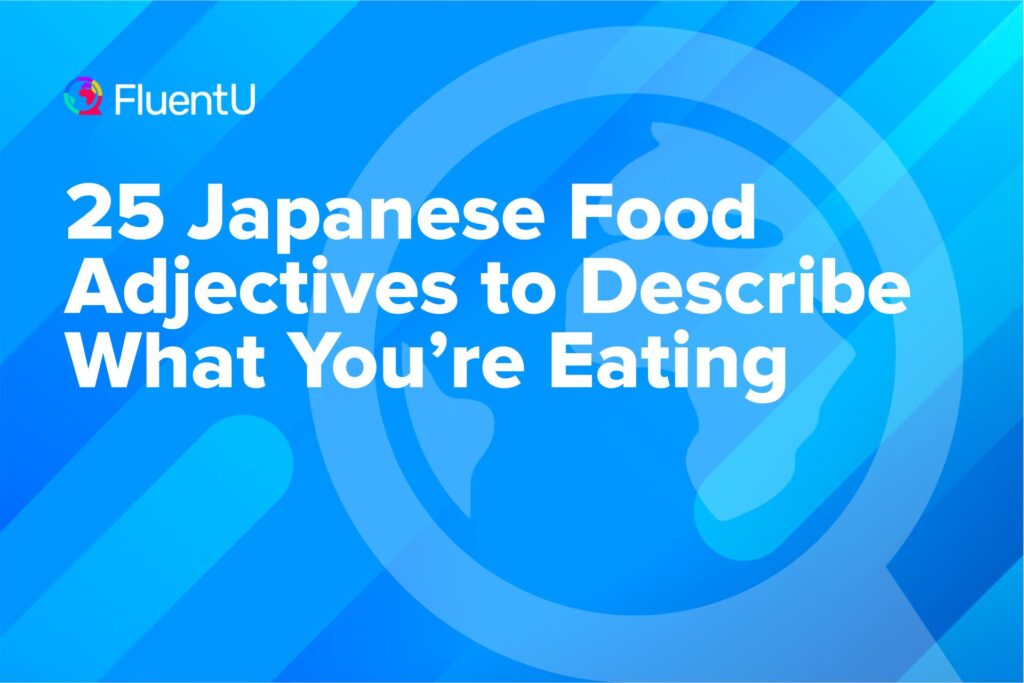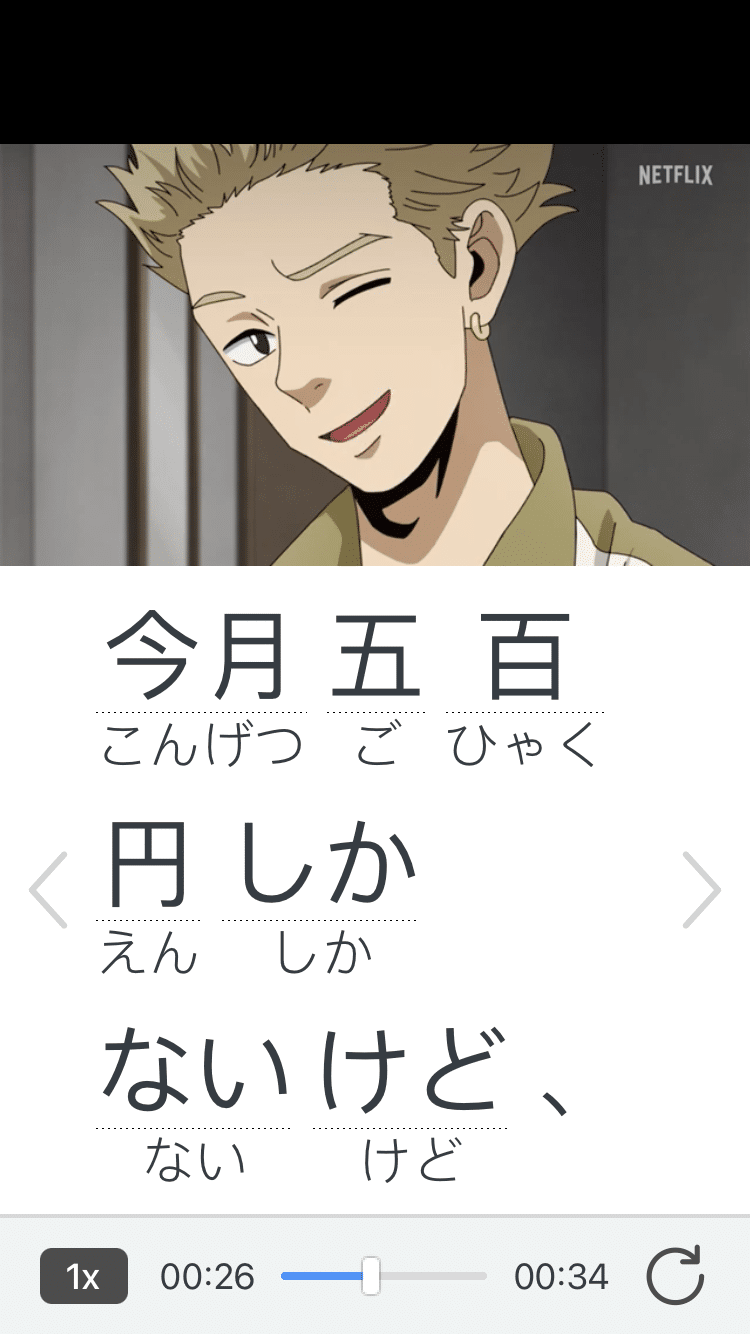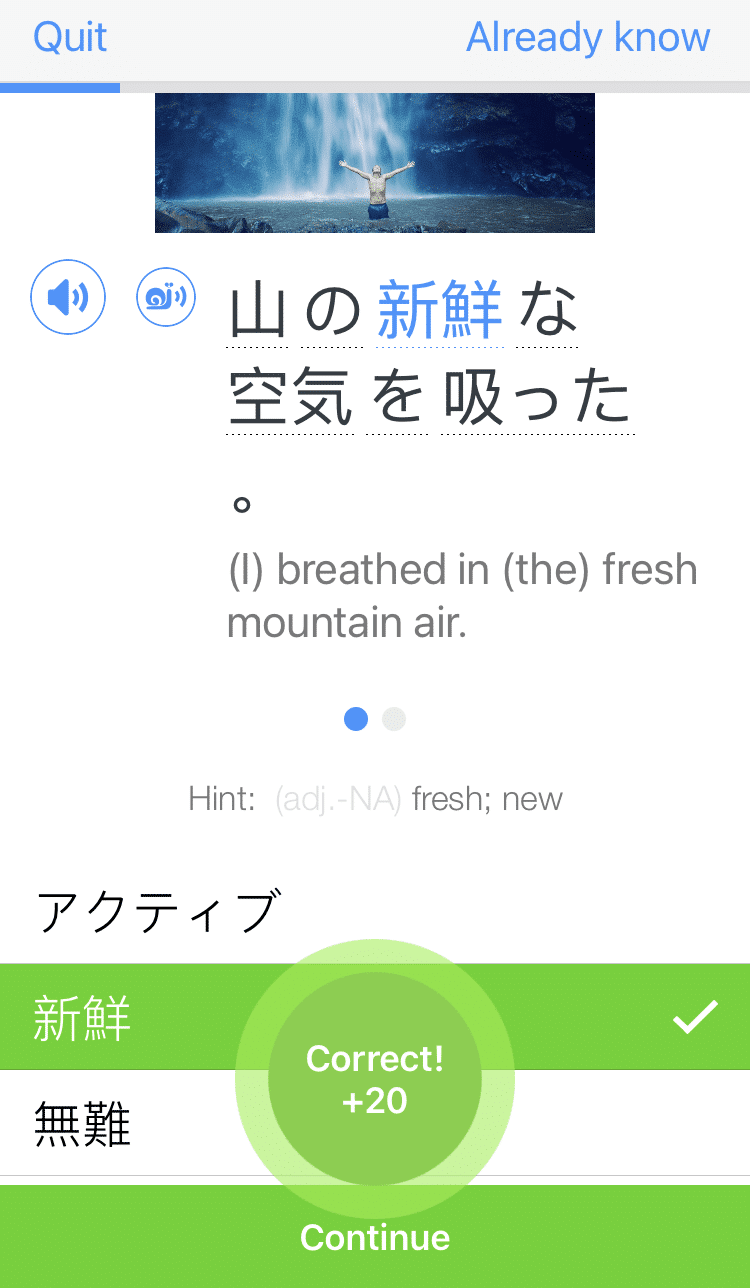Contents
- 25 Common Japanese Food Adjectives
- 生 (なま, raw)
- 甘い (あまい, sweet)
- 酸っぱい (すっぱい, sour)
- 塩っぱい (しょっぱい, salty)
- 苦い (にがい, bitter)
- 辛い (からい, spicy)
- 無味 (むみ, tasteless)
- 美味しい (おいしい, tasty)
- 香しい (かんばしい, fragrant)
- 臭い (くさい, smelly)
- 軟らかい (やわらかい, soft)
- 固い (かたい, hard)
- パリパリした (ぱりぱりした, crunchy)
- 新鮮 (しんせん, fresh)
- 古い (ふるい, old)
- 冷凍 (れいとう, frozen)
- 熱い (あつい, hot)
- 冷たい (つめたい, cold)
- 無農薬 (むのうやく, organic)
- みずみずしい (juicy)
- 乾燥 (かんそう, dry)
- 脂っこい (あぶらっこい, greasy)
- 濃厚 (のうこう, rich)
- 薄い (うすい, weak)
- 完璧 (かんぺき, perfect)
- Describing Food You Haven’t Tried Yet
- Describing Food with Verbs
- A Word on Japanese Food Culture
- And One More Thing...
25 Japanese Food Adjectives to Describe What You’re Eating

In any language, adjectives give us significant information about the nouns they describe, which can include all kinds of foods. Learning Japanese food adjectives will allow you to describe, discuss and even argue about the tastes, textures, smells and looks of various foods—all in Japanese.
Let’s go over some commonly used food adjectives in Japanese. Then, we’ll take things to the next level by learning grammar structures you can use to describe food before and after you’ve tasted it. We’ll even go a little beyond adjectives and get into more sophisticated and complex ways you can talk about your food.
Download: This blog post is available as a convenient and portable PDF that you can take anywhere. Click here to get a copy. (Download)
25 Common Japanese Food Adjectives
The following list will provide you with some basic knowledge of Japanese adjectives related to food. Each word will have one example sentence so that you can immediately get an idea of how you might use it. For additional support, visit FluentU, where you can see these adjectives in use through subtitled Japanese videos with support from other learning tools.
FluentU takes authentic videos—like music videos, movie trailers, news and inspiring talks—and turns them into personalized language learning lessons.
You can try FluentU for free for 2 weeks. Check out the website or download the iOS app or Android app.
P.S. Click here to take advantage of our current sale! (Expires at the end of this month.)

生 (なま, raw)
スズキは生だ!(すずきは なまだ!)
(The bass is raw!)
甘い (あまい, sweet)
このコーヒーは甘くないです。(この こうひいは あまくないです。)
(This coffee isn’t sweet.)
酸っぱい (すっぱい, sour)
オレンジはちょっと酸っぱいです。(おれんじは ちょっと すっぱいです。)
(Oranges are a bit sour.)
塩っぱい (しょっぱい, salty)
アンチョビはとても塩っぱいです。(あんちょびは とてもしょっぱいです。)
(Anchovies are very salty.)
苦い (にがい, bitter)
苦い薬が嫌いです。(にがい くすりが きらいです。)
(I hate bitter medicines.)
辛い (からい, spicy)
この食事は辛いですか?(このしょくじは からいですか?)
(Is this meal spicy?)
無味 (むみ, tasteless)
あけびは無味です。(あけびは むみです。)
(Akebi fruit is tasteless.)
美味しい (おいしい, tasty)
ケーキは美味しかったです! (けいきは おいしかったです!)
(The cake was delicious!)
香しい (かんばしい, fragrant)
このお茶はすごく香しいですよ。(このおちゃは すごく かんばしいですよ。)
(This tea is extraordinarily fragrant.)
臭い (くさい, smelly)
古い魚はとても臭いです。(ふるい さかなは とてもくさいです。)
(Old fish stinks a lot.)
軟らかい (やわらかい, soft)
軟らかい肉は最高です。(やわらかい にくは さいこうです。)
(Soft meat is the best.)
固い (かたい, hard)
そのキャンデイーは固いですか? (その きゃんでいいは かたいですか?)
(Are those candies hard?)
パリパリした (ぱりぱりした, crunchy)
パリパリしたスナックはありますか? (ぱりぱりした すなっくは ありますか?)
(Do you have any crunchy snacks?)
新鮮 (しんせん, fresh)
そこの店は果物がいつも新鮮です。(そこのみせは くだものが いつも しんせんです。)
(The fruits in that store are always fresh.)
古い (ふるい, old)
古い野菜は捨てなければなりません! (ふるい やさいは すてなければなりません。)
(Old vegetables should be thrown away!)
冷凍 (れいとう, frozen)
昨日買ったカニを冷凍しました。(きのうかった かにをれいとうしました。)
(I froze the crab I bought yesterday.)
熱い (あつい, hot)
スープはとても熱いです。(すうぷは とてもあついです。)
(The soup is very hot.)
冷たい (つめたい, cold)
冷たいビールをください。(つめたい びいるをください。)
(I’d like one cold beer, please.)
無農薬 (むのうやく, organic)
無農薬いちごは高いです。(むのうやくいちごは たかいです。)
(Organic strawberries are expensive.)
みずみずしい (juicy)
カキはみずみずしい果物です。(かきは みずみずしい くだものです。)
(The persimmon is a juicy fruit.)
乾燥 (かんそう, dry)
乾燥椎茸をください。(かんそう しいたけをください。)
(I’d like some dried shiitake mushrooms, please.)
脂っこい (あぶらっこい, greasy)
この肉は脂っこいですか? (このにくは あぶらっこいですか?)
(Is this meat greasy?)
濃厚 (のうこう, rich)
昨日、濃厚なラーメンを食べました。(きのう、のうこうな らあめんをたべました。)
(Yesterday I ate ramen with a rich taste.)
薄い (うすい, weak)
うどんは味がちょっと薄いです。(うどんは あじが ちょっと うすいです。)
(Udon has a bit of a weak taste.)
完璧 (かんぺき, perfect)
日本の料理は完璧です。(にほんの りょうりは かんぺきです。)
(Japanese cuisine is perfect.)
This should be enough to get you started.
But the next level up will be a bit more interesting, so if you’re ready, let’s move on!
Describing Food You Haven’t Tried Yet
To be precise, the structure below is used when describing something based on its appearance only. In other words, when you want to express the properties of an object, but you haven’t interacted with said object.
Here’s how the structure is built.
First, you need to put the adjective in its 連用形 (れんようけい, renyou form), or the continuative form as it’s called in English. You can build renyou form by removing the い from the end of an adjective.
Here are a couple of examples:
美味しい (おいしい, tasty) → 美味し (おいし)
軟らかい (やわらかい, soft) → 軟らか (やわらか)
Now that we have the renyou form, we can make our grammatical structure. All you have to do is add そう after the adjective, in place of that い we just removed, and here’s what we get:
美味しそう (おいしそう, tasty looking/seems tasty)
軟らかそう (やわらかそう, soft looking/seems soft)
Congratulations, you can now describe food without tasting it! Shall we try it out in a few sentences?
このデザートは美味しそうです!(この でざあとは おいしそうです!)
(This dessert looks tasty!)
このスープは熱そうです! (この すうぷは あつそうです!)
(This soup seems hot!)
そのりんごはみずみずしそうです。
(That apple looks juicy.)
たこ焼きは軟らかそうです。 (たこやきは やわらかそうです。)
(Takoyaki seems soft.)
Go ahead and try writing out a few sentences with this construction in them. Practice makes perfect!
Describing Food with Verbs
This time, we’ll describe food with verbs. Well, verbs that are a bit altered, but verbs nonetheless!
The below structure is used for describing the difficulty of performing an action. Of course, we’ll be using it only for describing food-related actions here.
Once again, we need the renyou form, but this time, instead of adjectives, we’ll be using verbs. The principle is pretty much the same, but with a slight difference. This is a tad more complicated, but bear with me.
First, we take the verb and put it in its masu form…
噛みます (かみます, to bite)
食べます (たべます, to eat)
Masu form is basically polite present tense, or polite future tense, depending on the context.
In other words, renyou form and masu form are the same. We just tend to call it masu form since it’s easier to remember. This may seem somewhat complicated to those of you who aren’t familiar with the concept, so let’s just take a second to clarify things.
Often, us foreign language learners like to adapt the things from a language we study so that they’re easier to remember and understand. In this case, English-speaking students, at some point, came up with the name “masu form” because it’s easier to remember than “renyou form.” The term “masu” comes from the ending of a word. For example:
行きます (いきます, to go)
あります (to have)
読みます (よみます, to read)
All end with masu, right?
This way, if you need the masu form, you can just think of the polite present or future form, and leave out the masu part, instead of going “Oh man, wait, does renyou form end with the i syllable or the a syllable?”
In this case, the masu form of our examples would be, 行き (いき), あり and 読み (よみ).
To summarize, masu form and renyou form are the same thing, and it’s used with both adjectives and verbs.
Having said all that, it’s time to continue with our main topic. Let’s get back to our examples and continue where we left off.
噛みます (かみます, to bite)
食べます (たべます, to eat)
Now just chop off that ending to get the masu/renyou form:
噛む (かむ) → 噛み (かみ)
食べる (たべる) → 食べ (たべ)
After that, we need to add the appropriate suffix: にくい if it’s hard to do and やすい if it’s easy to do.
噛み (かみ) → 噛みにくい/噛みやすい (かみにくい/かみやすい, hard to chew/easy to chew)
食べ (たべ) → 食べにくい/食べやすい (たべにくい/たべやすい, hard to eat/easy to eat)
Keep in mind that substituting adjectives with verbs is no easy feat. Adjectives exist for describing things and verbs for doing things, linguistically speaking. But since Japanese offers us a chance to train our brains a bit and do this, try to take full advantage of that in your food descriptions and switch things up.
Here are some examples for this grammatical construction, used for describing food in our case:
イカは噛みにくいですよ。(いかは かみにくいですよ。)
(Squid is hard to chew.)
バナナは腐りやすいですよ。(ばななは くさりやすいですよ。)
(Bananas rot easily.)
アイスクリームは食べやすいです。(あいすくりいむは たべやすいです。)
(Ice cream is easy to eat.)
このオレンジジュースは飲みやすいです。(この おれんじじゅうすは のみやすいです。)
(This orange juice goes down easy.)
Was I wrong when I told you this is way more fun than simply using adjectives? Try doing it yourself, you’ll see what I mean.
A Word on Japanese Food Culture
Japanese food culture consists of national cuisine, traditional food customs, proper eating etiquette and a few more tiny aspects like indigenous ingredients and such. Of course, all of those aspects have undergone some changes with time, which is a part of the culture as well.
Here are just a few key, interesting points you should know about Japanese food culture to put things into context before you start learning to describe Japanese food:
- The Japanese have a variety of expressions used before, during or after meals, far more than you often find in other languages.
- There are certain special kinds of meals served only at certain times. A good example of this is お節料理 (おせちりょうり), or the New Year’s food. A variety of dishes have special symbolic wishes for things like longevity, wealth, fertility and happiness.
- The modern age means modern influence and all kinds of new food with it. Japan is full of Western food, but even so, they tend to avoid mixing Western food with Japanese food. If you’re eating scrambled eggs, you won’t be eating sashimi with it.
The amazing and vast world of food in Japan is very special. From interesting and unique ingredients to simple but delicious dishes, as well as complex delicious ones, they have it all.
To show respect towards this part of Japanese culture, the least we can do is learn how to describe all of it with words!
This way, the next time you eat, cook or buy Japanese food, you won’t have to worry if you got what you wanted or accidentally disrespected the cook with your lack of appropriate adjectives.
Download: This blog post is available as a convenient and portable PDF that you can take anywhere. Click here to get a copy. (Download)
And One More Thing...
If you love learning Japanese with authentic materials, then I should also tell you more about FluentU.
FluentU naturally and gradually eases you into learning Japanese language and culture. You'll learn real Japanese as it's spoken in real life.
FluentU has a broad range of contemporary videos as you'll see below:

FluentU makes these native Japanese videos approachable through interactive transcripts. Tap on any word to look it up instantly.

All definitions have multiple examples, and they're written for Japanese learners like you. Tap to add words you'd like to review to a vocab list.

And FluentU has a learn mode which turns every video into a language learning lesson. You can always swipe left or right to see more examples.

The best part? FluentU keeps track of your vocabulary, and gives you extra practice with difficult words. It'll even remind you when it’s time to review what you’ve learned. You'll have a 100% personalized experience.
Start using the FluentU website on your computer or tablet or, better yet, download the FluentU app from the iTunes or Google Play store. Click here to take advantage of our current sale! (Expires at the end of this month.)







